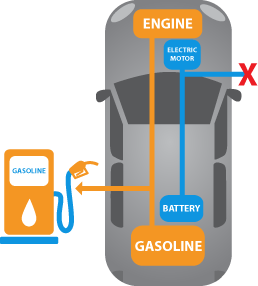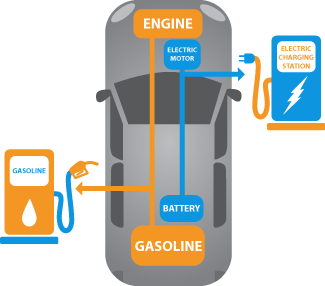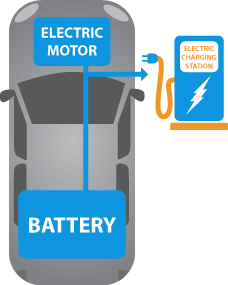GETTING TO KNOW ELECTRIC VEHICLE TYPES

HEV (Hybrid Electric Vehicle)
HEVs are powered by an internal combustion engine (gasoline) combined with one or more motors (electric) that draw energy stored from rechargeable batteries.
HEVs cannot plug-in to an external power source to charge the batteries (HEVs aren't typically considered 'electric vehicles'). Instead, they use 'regenerative braking' and the internal combustion engine to recharge. Upon braking, the electric motor acts as a generator, capturing lost energy during braking and storing it in the battery.
Smaller engines are possible due to extra help from the electric motor. The battery also assists in powering auxiliaries such as sound systems/headlights and reducing engine idle when the vehicle is stopped.
HEV examples: Honda Insight, Toyota Prius, Ford Fusion Energi

PHEV (Plug-in Hybrid Electric Vehicle)
PHEV contains two sources of energy: an electric motor with a larger rechargeable battery and an internal combustion (gasoline) engine. Unlike HEVs, batteries can be recharged by plugging into an external electric power source.
Typically, PHEVs will start-up in electric-mode. Upon battery depletion, the internal combustion engine kicks in, thus operating as a conventional non-plug-in hybrid. Whereas conventional internal combustion vehicles rely entirely on friction to slow, PHEVs 'regenerative braking' uses the electric motor as a generator, capturing some of that lost kinetic energy and storing it in the battery.
Since PHEVs can operate on electricity from the grid, these types of EVs offer much-improved environmental performance and significantly reduce the cost of fuel by substituting grid electricity for gasoline.
PHEV examples: Chevrolet Volt, Toyota Prius Prime, Mitsubishi Outlander, Kia Niro

BEV (Battery Electric Vehicle)
Unlike HEVs and PHEVs that contain an internal combustion engine alongside an electric motor, BEVs (also known as 'all-electric' vehicles) are strictly battery-powered vehicles. The battery is charged by grid electricity (either a wall-socket or designated electric vehicle charging equipment).
Like HEVs and PHEVs, BEVs feature 'regenerative braking' as well as 'idle-off' (turning the car off when stopped).
BEVs have the benefit of home recharging as well as an increase of public and workforce charging stations becoming widely available.
BEV examples: Chevrolet Bolt, Nissan LEAF, Tesla, Volkswagen e-Golf, BMW i3
State Funding, Tax Credits, Incentives, & Rebates
Besides the benefits of driving an electric vehicle (ultra-low emissions and overall cost-effectiveness to name a few), many states in the US offer incentives to purchase an electric vehicle and/or electric vehicle charging stations and equipment.
To find out if your state offers funding for electric vehicles and charging equipment, please visit this page.
|